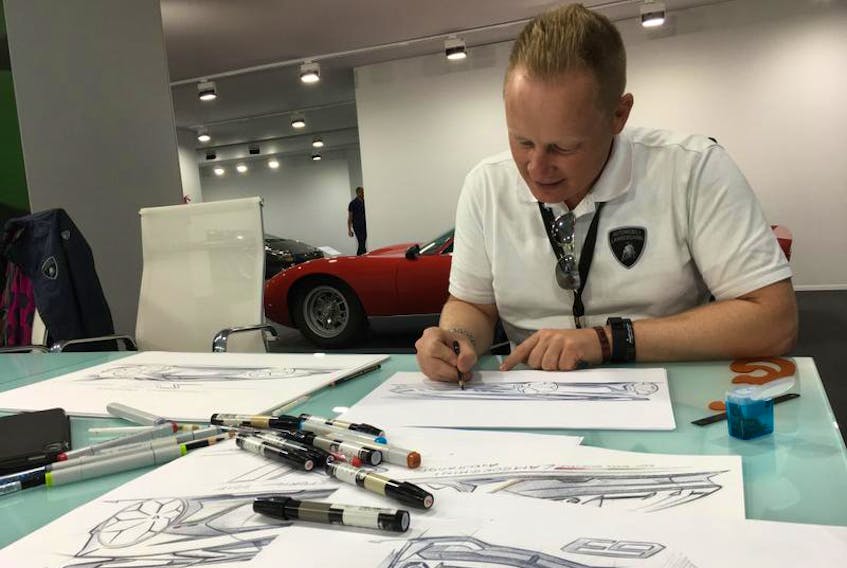to be a designer is a package deal: personality, talent, taste, endurance to reach a goal, ideas...”
- Mitja Borkert
TORONTO — Mitja Borkert has one of the best jobs in the entire automotive industry, maybe one of the best jobs in the world.
He is the head of Centro Stile, Lamborghini’s design centre. He draws supercars, and then they become real.
When we meet he is hunched over a stack of loose paper with pencil in hand, doing sketch after sketch of an Aventador SVJ, trying to get the lines just right.
“I can’t draw people,” he confesses. The drawings on the table are all cars. “I’m not the best sketcher in the world, there are hundreds better. But, to be a designer is a package deal: personality, talent, taste, endurance to reach a goal, ideas...”
The stories of how Borkert and other leading automotive designers launched their careers are a useful reality check for anyone who has ever dreamed of making their own Homer Simpson mobile. This job requires an unusual kind of creative obsession.
For sure it’s the same with fashion designers, industrial designers; you need to feel it in your stomach.”
- Yasutake Tsuchida
Borkert grew up in East Germany. “When I was young, it was like North Korea you know, basically behind the curtain,” he says. One year, while on vacation with his older brother in Hungary, he saw his first foreign motorcycles — a Suzuki GSX-R and Kawasaki ZX-7R. “They were going like” — he makes a sound like a 750cc inline-four spinning at 11,000 rpm — “and this was it.” In that instant he became a gearhead. He began cutting pictures of cars and motorcycles out of all the magazines he could get his hands on.

Yasutake Tsuchida, chief designer of the new Mazda3, had a similar eureka moment. His father worked at a Mazda dealership. “When I was in junior high school, my father came home driving a third-generation (1992-2002) Mazda RX-7, and I fell in love with it,” he says. From then on, he was drawing cars in his school notebooks. It’s a typical story for professional car designers, Tsuchida says.
“When I listen to my colleagues,” Borkert says, “all of them by age 11, 12, 14 had the passion to draw cars. For sure it’s the same with fashion designers, industrial designers; you need to feel it in your stomach.”
If it weren’t for the fall of the Berlin Wall, he doesn’t think he would’ve had a chance to study transportation design at the Design University of Pforzheim. Borkert realized how lucky he’d been. “From that moment on I was unstoppable doing design.”
“If you’re a kid in Canada,” he said, “your next opportunity would be maybe Detroit (College for Creative Studies) or, the best place in America is Pasadena (the ArtCentre College of Design). But it’s also quite expensive.”
Closer to home, Humber College, Carlton University and the University of Montreal all have industrial design programs that could lead to careers in the automotive industry. The few Canadians working today as top automotive designers — such as Karim Habib at Infiniti and Ralph Gilles at FCA — had to leave the country to study.
Entrance to the top transportation design programs is highly competitive. Automakers recruit new designers through university internships, which is how Borkert got his start at Porsche.
A transportation design degree hasn’t always been a necessary qualification though.

Benoit Jacob is one of the industry’s great visionaries. After creating the original BMW X6 — a car that spawned an entirely new niche — and the brand’s brilliant first electric car, the i3, Jacob left BMW to become VP of design at the Chinese electric-car startup Byton. His career began with no formal degree and a bundle of sketches. As he tells it, he walked into Renault, laid his work out and said, “I want to do car design.”
The company took a chance on him, which turned out to be a wise decision. At Renault, Jacob designed sedans and wagons, the cute Fiftie coupe concept, and the now-classic Renault Sport Spider.
“At that time, that was probably the last call, when car design was still kind of exotic and teams were relatively small,” he says. “I think today if I walked in and showed stuff I would probably not get a job.”
When Borkert gets asked, “how can I learn to be a designer?” he tells them that’s the wrong question. “You have to feel that already inside of you ... If you have the talent for drawing it’s one thing, but having the imagination for something new is another. I’d rather [hire] someone who can’t draw so well, but has ideas and visions.”
To date, Borkert’s credits include the Porsche Panamera Sport Turismo wagon, Macan SUV and electric Mission E concept. Since taking the top design job at Lamborghini in 2016, he has overseen the creation of the Urus SUV and Terzo Millennio concept that will define the brand’s the next-generation hybrid supercars. Not bad for a kid with so-so grades who barely got into high school in East Germany.
For the record, he now has a very nice collection of exotic motorcycles.









